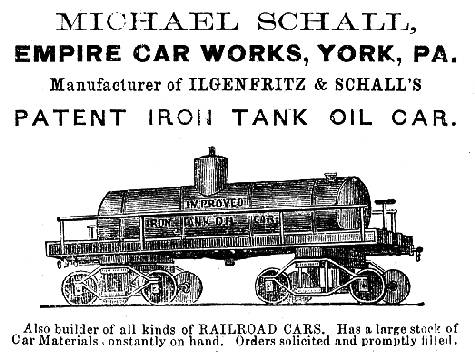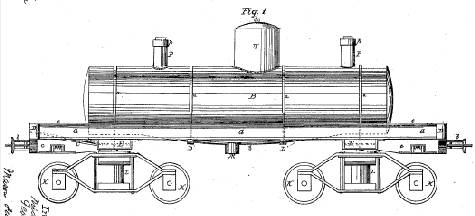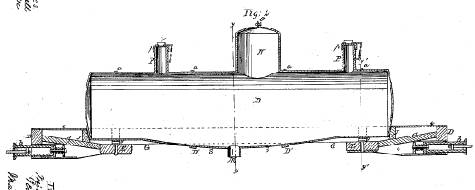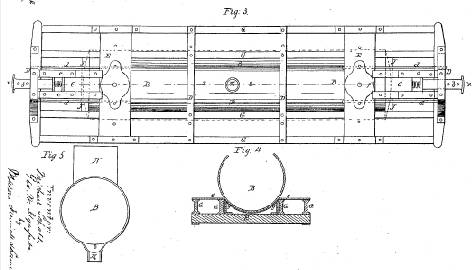Empire Car Works
Founders of the company were George Ilgenfritz and Michael Schall. Ilgenfritz had apparently been building railway cars off-and-on since about 1849, possibly at sometime around 1859 in partnership with someone named White. {246} About 1867 young Arthur King came to work for them and a year later married Ilgenfritz’ daughter Lydia. He soon became foreman of the shop. On 7 July 1868, Ilgenfritz and Schall obtained a patent on a fish-belly tank car (Pat. No. 79,573). Note that the tank bottom slopes to a point slightly below the frame to ensure full discharge of the cargo and any sediments. The tank sets low on the frame to lower the center of gravity. The frame consists of two pairs of twin I-beams, with the tank set low between the two pairs. Long end decks create a collision barrier protecting the ends of the tank. Patent views of this car are shown below.
Railroad historian John H. White, Jr., says Empire “was a major freight car builder at the time this patent was issued [1868].” {111} In 1873, the Empire works had two parallel tracks, 260 feet long. Cars were assembled on one track while the other was used to bring in materials and sub-assemblies. Pre-assembled trucks were started down the assembly track. One crew assembled the bolsters, frame and draft gear then moved the car along. The next crew nailed together the car body and roof, then moved the car along. The next crew painted the completed car. This “long track” system, as White calls it, become the dominant assembly method into the twentieth century. {111} It is not certain just how long the Empire works was in business. We have found mention of it as one of the two car builders—Billmeyer & Small being the other—in business at York in 1884. But we have found no mention of it after that. [112] We do know that after 1879, the attentions of Schall and King were turned elsewhere as they resurrected the moribund Middletown Car Works 16 miles north of York at Middletown. Cast of Characters —George W. Ilgenfritz (1821-1891) Went to work at age 12. Learned blacksmithing and coach building. Opened up a shop in 1845 to build agricultural machinery. Began building cars a few years later. Thirty year old George W. Ilgenfritz, car builder, is found in the 1850 U.S. Census in York, Pennsylvania, on 2 September 1850, with property of $6,000. He may have partnered with ____ White, as an article in the Gettysburg newspaper for 6 June 1859 brags about “the beautiful [passenger] car just completed for our railroad by Ilginfritz [sic] & White, machinists and car-builders at York.” [246] By 1867 he claimed to be building 75-100 freight cars a month. Quit the field temporarily after an argument with Schall. He is not found at York in the 1880 Census. He later re-entered the car business and remained active until ill health force his retirement. Arthur King (1841-1917) was born in Virginia. His father was the Master Armorer at the Federal Arsenal at Harper’s Ferry. His family moved to Martinsburg, Pennsylvania, where Arthur was apprenticed to a machinist. At the outbreak of the Civil War, he moved to Philadelphia, where he worked as a rifle maker. After the war, about 1867, he moved to York, Pennsylvania, where he went to work in the car works, became a foreman, and in 1868 married Lydia Ilgenfritz, the boss’ daughter. In 1879, he joined with Michael Schall in reopening the Middletown Car Works. Michael Schall (c1822-1904) Twenty-eight year old Michael Schall is found in the 1850 census for York, PA as a clerk. Fifty-two year old Michael Schall, car builder, is found in the 1880 U.S. Census in York, PA. In 1891, Schall failed because of overspeculation. |



